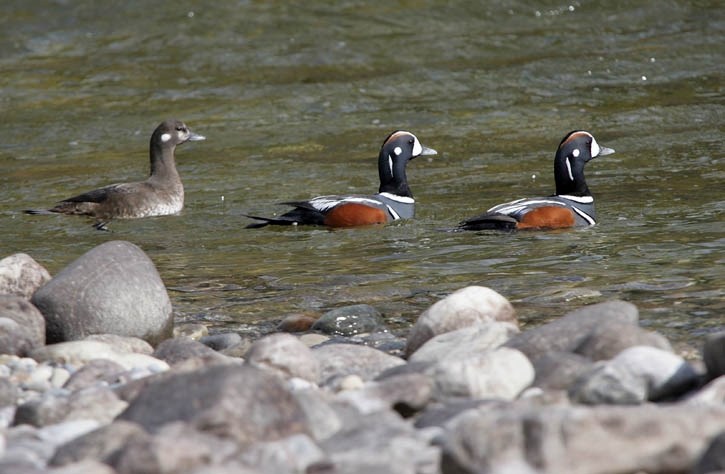Parks Canada is asking for the public’s help in reporting any sightings of harlequin ducks amid fears flood waters in early June may have wiped out most of the nests.
Officials say the public’s sightings of female harlequins – with or without broods – will help Parks Canada plan their duckling surveys, both roadside and by canoe.
Parks Canada hopes to determine whether the flood events of June 5-6, when parts of the region were hit with 80mm to 100 mm of rain in a 48-hour period and led to swollen rivers, have affected the colourful sea ducks.
Shelley Humphries, an aquatics specialist for Lake Louise, Yoho and Kootenay, said June 1 is the median egg-laying date and July 12 is the median hatch date for harlequin ducks.
“Some females would have had full nests and most females would have had some eggs in the nest when the huge flooding happened on June 5 and 6,” Humphries said.
“We’re pretty sure any females nesting on the Bow or Pipestone or Baker Creek probably lost their nests, although birds nesting on Moraine Creek may have been OK because the creek didn’t come up as much.”
That said, Humphries said Parks Canada did look at historic nesting locations on Moraine Creek after the regional flooding, but they didn’t find any nests.
“We didn’t find any nests, but we could have missed them,” she said. “We don’t know if the females who lost their nests had time to try again – depending on if their mate was still there or their body condition was good – but it’s possible.”
Harlequin ducks, designated a species of special concern in Alberta, are small sea ducks that winter in coastal areas on the Pacific and migrate inland during spring and summer to nest along clean, turbulent mountain streams.
The Bow River seems to be particularly important as a staging and breeding area, with the stretch between Lake Louise and Castle Junction having one of the highest concentrations for a spring range in western North America.
The ducks begin arriving in April, with males returning to the Pacific coast in mid-June or early July, leaving the females to raise broods. The hens and their broods typically head back to the coast from mid-August to mid-September.
Harlequins are very sensitive to disturbance, and are particular about their nesting requirements on islands or stream banks. They need to be away from human disturbance and seeking cover from natural predators.
Young female ducks tend to return to the same place they were reared. The hens may be at least four years old before producing their first ducklings and may not breed each year.
“Harlequins are like grizzly bears, they live a bit longer than other ducks, and one bad year is not the end of the world,” Humphries said.
“They still have time to make a contribution, but we haven’t seen a lot of ducklings over the past few years on this section of the river.”
In May, Parks Canada staff and volunteers spent three days at various locations where the sea birds come inland to breed and nest. A total of 14 harlequins were caught and banded, including six pairs and two individual males.
Harlequin numbers have been gradually and steadily declining along a stretch of the Bow between Castle Mountain and Lake Louise, from a high of around 45 in 1995 to less than 20 individuals observed last year.
“We’re definitely keeping on eye on this,” Humphries said.
Sightings of harlequin ducks in Banff, Yoho and Kootenay national parks can be reported to Shelley Humphries at [email protected] or [email protected]
During hatch week, the ducklings appear as yellow and brown puffballs and will quickly lose their yellow and become more light brown with dark markings.
By now, the ducklings are starting to look a bit more like the hen, except they can’t fly. A hen has a single distinctive white patch on the side of its head.
Parks Canada asks that people try not to disturb harlequins for photos because for the first few weeks ducklings are not strong swimmers and won’t survive if they get separated.
“If people have any observations, please go to the information centres and fill out a form or e-mail us,” Humphries said.




